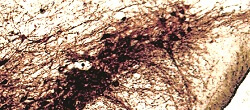Johns Hopkins: Researchers report they have discovered how two problem proteins
known to cause Parkinson’s disease are chemically linked, suggesting
that someday, both could be neutralized by a single drug designed to
target the link. A report on their discovery appears in the Jan. 24
issue of Cell Reports. The investigators’ new experiments build on evidence reported in 2011
that reducing the amount of a protein called PARIS in mice with the
rodent equivalent of Parkinson’s disease protects against the loss of
dopamine-making neurons.
Since then, according to Ted Dawson, M.D., Ph.D.,
professor of neurology and director of the Institute for Cell
Engineering at the Johns Hopkins University School of Medicine, the
research team suspected PARIS was linked chemically to other important
Parkinson’s proteins. “In this study, we were able to confirm that
suspicion,” he says.
Dawson explains that a hallmark of Parkinson’s disease is the
death of brain cells that produce the signaling molecule, or
neurotransmitter, dopamine. Dopamine depletion, in turn, causes the
classic symptoms of Parkinson’s disease, such as tremors, muscle
stiffness and lack of muscle coordination. Mutations in the gene for a
protein called Parkin are known to cause the death of dopamine neurons;
less commonly, defects in another protein, PINK1, can have the same
effect.
In mouse experiments done in collaboration with researchers at
Mayo Clinic in Florida, Dawson’s team investigated whether both proteins
might act through a single intermediary: PARIS.
In their 2011 study, Dawson and his collaborators had used mice
and human brain tissue to find that Parkin adds a chemical tag known as
ubiquitin to PARIS that signals other proteins to break it down.
To find out whether PINK1 and PARIS have a similar relationship,
the researchers ran biochemical tests on purified proteins that revealed
that PINK1 and PARIS interact. Dawson says the results revealed that
while PINK1’s normal role is to add a chemical tag known as a phosphate
group to a certain spot on the PARIS protein, defective forms of PINK1
linked to Parkinson’s disease cannot add that tag.
The phosphate addition, he says, kicks off a chain of events that
ultimately leads to the dismantling of the PARIS protein, Dawson says, a
cause-and-effect relationship his team verified by reducing the amount
of PINK1 in lab-grown human cells, which led to a threefold increase in
the amount of PARIS. Similarly, reducing the amount of PINK1 made in
living mice by more than 80 percent led to a doubling in the amount of
PARIS present.
In another experiment, the research team ramped up PINK1
production in lab-grown human cells and found that the resulting
increase in cell death was alleviated if PARIS levels also increased. But
if PARIS was tweaked to eliminate the sites where PINK1 normally adds a
phosphate group, PINK1 was unable to rescue the cells.
Since both Parkin and PINK1 protect brain cells by causing PARIS’
breakdown, Dawson suggests that defects in either could be remedied if a
treatment can be found that hobbles PARIS. “Mutations in the genes for
both Parkin and PINK1 have now been linked to Parkinson’s disease,” he
says. “Parkin is a particularly big player that seems to be at fault in
many inherited cases; it’s also inactivated in sporadic cases of the
disease. So a drug targeting PARIS could potentially help many
patients.”
More than 1 million people in the United States live with
Parkinson’s disease. The disease gradually strips away motor abilities,
leaving people with a slow and awkward gait, rigid limbs, tremors,
shuffling and a lack of balance. Its causes are not well-understood.
Currently available treatments, such as medications and deep brain
stimulation, can alleviate symptoms but do not cure it or slow its
progression.
Dawson emphasizes that clinical application of their discovery
must await not only further studies in animals, but also years of drug
design and clinical research. But he says their discovery has the
potential to simplify and focus the development of better treatments.
Other authors on the paper are Yunjong Lee, Daniel A. Stevens,
Sung-Ung Kang, Haisong Jiang, Yun-Il Lee, Han Seok Ko, Leslie A.
Scarffe, George E. Umanah, Hojin Kang, Sangwoo Ham, Tae-In Kam, Kathleen
Allen, Saurav Brahmachari, Jungwoo Wren Kim, Stewart Neifert, Seung Pil
Yun, Valina L. Dawson and Joo-Ho Shin, all of the Johns Hopkins
University School of Medicine, and Fabienne C. Fiesel and Wolfdieter
Springer of Mayo Clinic.
This work was supported by grants from the National Institute of
Neurological Disorders and Stroke (grant numbers NS38377 and R01
NS085070), the JPB Foundation, the Samsung Biomedical Research
Institute, the Michael J. Fox Foundation for Parkinson’s Research and
the Foundation for Mitochondrial Medicine, the Mayo Clinic Foundation,
the Centers for Individualized and Regenerative Medicine, the Marriott
Family Foundation, a Gerstner Family Career Development Award, a
fellowship from the American Parkinson Disease Association, the National
Research Foundation of Korea (grant numbers NRF-2016R1A2B4008271 and
2015R1C1A1A01052708) and a Samsung Biomedical Research Institute grant
(grant numbers SMX1161351 and SMX1161191). The authors acknowledge the
joint participation by the Adrienne Helis Malvin Medical Research
Foundation and the Diana Helis Henry Medical Research Foundation through
their direct engagement in the continuous, active conduct of medical
research in conjunction with The Johns Hopkins Hospital, the Johns
Hopkins University School of Medicine and the Foundation’s Parkinson’s
Disease Programs M-1, M-2, H-2014. T. Dawson is the Leonard and Madlyn
Abramson Professor of Neurodegenerative Diseases.
Research discussed in this publication involves technology that
Ted and Valina Dawson anticipate Valted, LLC may own or license in the
future. Ted and Valina Dawson are founders of Valted, LLC and hold
ownership equity interest in the company. This arrangement has been
reviewed and approved by the Johns Hopkins University in accordance with
its conflict of interest policies.
